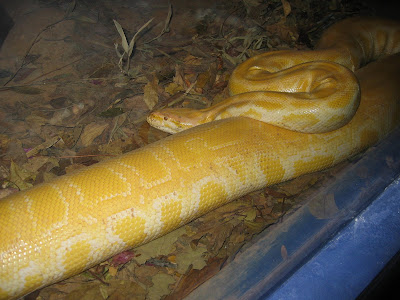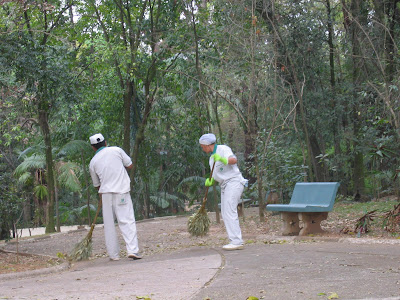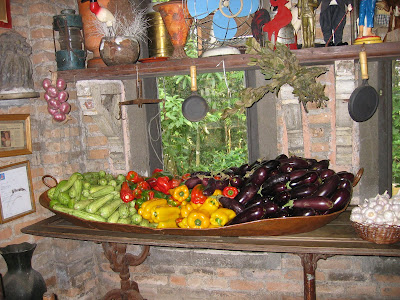After the end of the civil war many of the confederates refused to accept the victory of the north and left the United States with their families, households and even some of their slaves. They were so overcome bitterness and resentment with the defeat of their cause that they left the land of their forefathers and never returned. A significant number of them came to Brazil. The exact number is not known but probably it was well into the thousands.
They settled in various places in this country with the largest groups making their homes in the state of Sao Paulo. Last Friday, the 15th of August 2008, we drove the 130 kilometers north from the MTC to visit the place where they built a new life for themselves. This area now has two neighboring cities called "Americana" and Santa Barbara D'oeste (America and Santa Barbara of the West)
This sign marks the road that leads to a cemetary and park maintained today by an association of the descendents of those early southern settlers. (Highway of the Confederates) It was a dirt road bounded on both sides by sugar cane fields strechting in all direction as far as we could see.

When we entered the park one of the first things we saw was this monument below with the confederate flag flanked on each side by the last names of many of the families that took up there residence in this area.

Jerry found a family with her maiden name.

Is there any doubt to whom these people were loyal? Many other confederate generals flanked Robert E. Lee on the walls of this small but well maintained museum.

Because the Catholic Church would not allow non catholics to be buried in their cemetaries, these southerners built their own complete with the first Baptist chapel in Brazil. This building is the third one built on this spot. The first was destroyed by fire and the second fell into disrepair. This one is about 45 years old. Here we are about to enter into the bulding...

.... and coming back out.

There were several hundred graves here some of which were quite new (2006). Many dated back to the 1870s and 80s. Almost all were inscribed in English.

The lady in the baseball cap is the wife of the caretaker. I got the idea that she does most of the work because her husband has to practice his trade of stone mason away from this location in order to make a living. Their home is here and she regularly hosts visitors from elementary school children to VIPs from foreign countries. She dropped what she was doing to show us around and was very gracious to us.

An old and interesting tree that may have been here when these families arrived in the late 1860s.

Sugar cane fields like this one surround the cemetery and park.

Harvesting the cane begins by starting a fire in the canefield to clear the undergrowth just before cutting the cane. Then it is stacked in piles like these.

After the field is cleared it looks like this.

The cane is then loaded into huge trailers like these and taken to the sugar refineries. Most of the cane in Brazil is used in the production ethonol. Brazil is the world leader in production of flex fueled vehicles and the use of motors that run on alcohol.

In case you've never seen how bananas grow, here's how its done.

And Mamao (Papaya)

These blossoms were on a tree in cemertary.

This is a museum in the city of Santa Barbara which was as clean and well maintained a building as I have ever seen. It is full of memorabiltia of these folks that came to Brazil. They originally planted cotton but gradually switched to sugar cane over the course of decades.

In front of the museum we had to pay a young man who worked for the city to park on the city street.

The museum is behind me. The city office of the mayor is to the right.

On the way home to Sao Paulo on the Banderantes Highway.

Well its time to say good by. Tomorrow is Sunday and our day starts early.
Love.... Mom and Dad/Grandma and Grandpa/Vernon and Jerry












 To make it feel more like P-day, President Woodward and I took our ties off. Although we love our work, it is both relaxing and refreshing to get away for a few hours each week.
To make it feel more like P-day, President Woodward and I took our ties off. Although we love our work, it is both relaxing and refreshing to get away for a few hours each week.










 Jerry found a family with her maiden name.
Jerry found a family with her maiden name. Is there any doubt to whom these people were loyal? Many other confederate generals flanked Robert E. Lee on the walls of this small but well maintained museum.
Is there any doubt to whom these people were loyal? Many other confederate generals flanked Robert E. Lee on the walls of this small but well maintained museum.  Because the Catholic Church would not allow non catholics to be buried in their cemetaries, these southerners built their own complete with the first Baptist chapel in Brazil. This building is the third one built on this spot. The first was destroyed by fire and the second fell into disrepair. This one is about 45 years old. Here we are about to enter into the bulding...
Because the Catholic Church would not allow non catholics to be buried in their cemetaries, these southerners built their own complete with the first Baptist chapel in Brazil. This building is the third one built on this spot. The first was destroyed by fire and the second fell into disrepair. This one is about 45 years old. Here we are about to enter into the bulding... .... and coming back out.
.... and coming back out. There were several hundred graves here some of which were quite new (2006). Many dated back to the 1870s and 80s. Almost all were inscribed in English.
There were several hundred graves here some of which were quite new (2006). Many dated back to the 1870s and 80s. Almost all were inscribed in English. The lady in the baseball cap is the wife of the caretaker. I got the idea that she does most of the work because her husband has to practice his trade of stone mason away from this location in order to make a living. Their home is here and she regularly hosts visitors from elementary school children to VIPs from foreign countries. She dropped what she was doing to show us around and was very gracious to us.
The lady in the baseball cap is the wife of the caretaker. I got the idea that she does most of the work because her husband has to practice his trade of stone mason away from this location in order to make a living. Their home is here and she regularly hosts visitors from elementary school children to VIPs from foreign countries. She dropped what she was doing to show us around and was very gracious to us. An old and interesting tree that may have been here when these families arrived in the late 1860s.
An old and interesting tree that may have been here when these families arrived in the late 1860s. Sugar cane fields like this one surround the cemetery and park.
Sugar cane fields like this one surround the cemetery and park. Harvesting the cane begins by starting a fire in the canefield to clear the undergrowth just before cutting the cane. Then it is stacked in piles like these.
Harvesting the cane begins by starting a fire in the canefield to clear the undergrowth just before cutting the cane. Then it is stacked in piles like these.
 The cane is then loaded into huge trailers like these and taken to the sugar refineries. Most of the cane in Brazil is used in the production ethonol. Brazil is the world leader in production of flex fueled vehicles and the use of motors that run on alcohol.
The cane is then loaded into huge trailers like these and taken to the sugar refineries. Most of the cane in Brazil is used in the production ethonol. Brazil is the world leader in production of flex fueled vehicles and the use of motors that run on alcohol.



 In front of the museum we had to pay a young man who worked for the city to park on the city street.
In front of the museum we had to pay a young man who worked for the city to park on the city street.  The museum is behind me. The city office of the mayor is to the right.
The museum is behind me. The city office of the mayor is to the right. On the way home to Sao Paulo on the Banderantes Highway.
On the way home to Sao Paulo on the Banderantes Highway.




 This is the scene looking down from the window above. Just to the right of the two buses is another wonderful museum of art featuring many Brazilian artist. Jerry is loving these trips. But I think we all do. We usually travel with 2 other couples. Arlan and Sally Woodward, MTC President and Ray and Joanne Linford, MTC and Area Medical Advisor.
This is the scene looking down from the window above. Just to the right of the two buses is another wonderful museum of art featuring many Brazilian artist. Jerry is loving these trips. But I think we all do. We usually travel with 2 other couples. Arlan and Sally Woodward, MTC President and Ray and Joanne Linford, MTC and Area Medical Advisor. 
 We are exiting the museum. Directly in front of us is an elevator which takes us 4 stories down beneath the city to the subway station. They call the subway the Metro (accent on the O).
We are exiting the museum. Directly in front of us is an elevator which takes us 4 stories down beneath the city to the subway station. They call the subway the Metro (accent on the O). This is one the many connecting tunnels below the city of Sao Paulo. This shot was taken about 3:00 pm. In another hour or so this very spot will have 3 or 4 times more people rushing to catch their train back to their homes. The greater Sao Paulo area is said to have about 18 million people.
This is one the many connecting tunnels below the city of Sao Paulo. This shot was taken about 3:00 pm. In another hour or so this very spot will have 3 or 4 times more people rushing to catch their train back to their homes. The greater Sao Paulo area is said to have about 18 million people..JPG) I shouldn't get too far out. These trains come by every 3 to 5 minutes and are often traveling very quickly.
I shouldn't get too far out. These trains come by every 3 to 5 minutes and are often traveling very quickly. Relatively uncrowded at this time of day
Relatively uncrowded at this time of day Transfering from the Metro to the bus on the last leg of our return trip to the MTC. The lady facing me is Sister Joanne Linford. She is the wife of the MTC medical Doctor, Ray Linford. There wonderful people are serving their fourth mission. We have grown to love them dearly and will miss them when they return home in September of 2008
Transfering from the Metro to the bus on the last leg of our return trip to the MTC. The lady facing me is Sister Joanne Linford. She is the wife of the MTC medical Doctor, Ray Linford. There wonderful people are serving their fourth mission. We have grown to love them dearly and will miss them when they return home in September of 2008 View from the from the bus on the way home.
View from the from the bus on the way home.
 This is the "Marginal Tiete". It is a river that almost rings the older sections of the city. The MTC lies outside this older portion of Sao Paulo. Before coming to Brazil we asked our Freind Allen Ostergar how far it was from the MTC to the Temple. He then asked me, "At what time of day?" I didn't fully appreciate what he meant. I do now. You must always remember when the traffic begins to get busy and for how long it will remain so whenever you consider driving any where in Sao Paulo.
This is the "Marginal Tiete". It is a river that almost rings the older sections of the city. The MTC lies outside this older portion of Sao Paulo. Before coming to Brazil we asked our Freind Allen Ostergar how far it was from the MTC to the Temple. He then asked me, "At what time of day?" I didn't fully appreciate what he meant. I do now. You must always remember when the traffic begins to get busy and for how long it will remain so whenever you consider driving any where in Sao Paulo.
